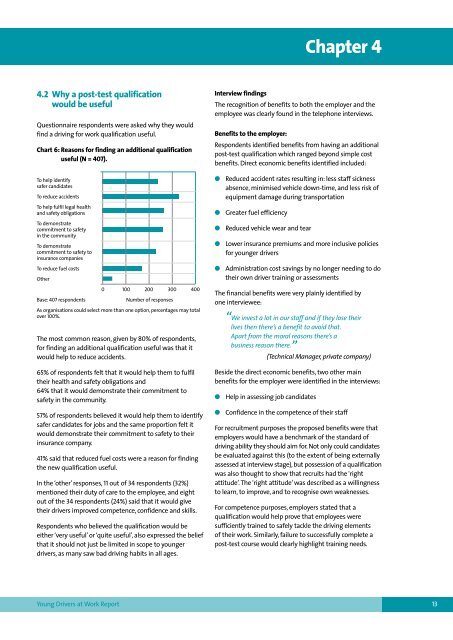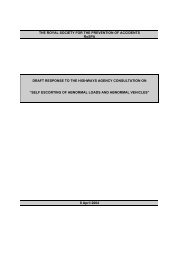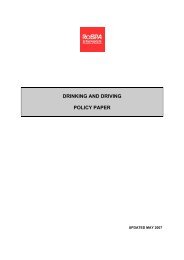RoSPA Young Drivers at Work Report
RoSPA Young Drivers at Work Report
RoSPA Young Drivers at Work Report
Create successful ePaper yourself
Turn your PDF publications into a flip-book with our unique Google optimized e-Paper software.
Chapter 4<br />
4.2 Why a post-test qualific<strong>at</strong>ion<br />
would be useful<br />
Questionnaire respondents were asked why they would<br />
find a driving for work qualific<strong>at</strong>ion useful.<br />
Chart 6: Reasons for finding an additional qualific<strong>at</strong>ion<br />
useful (N = 407).<br />
To help identify<br />
safer candid<strong>at</strong>es<br />
To reduce accidents<br />
To help fulfil legal health<br />
and safety oblig<strong>at</strong>ions<br />
To demonstr<strong>at</strong>e<br />
commitment to safety<br />
in the community<br />
To demonstr<strong>at</strong>e<br />
commitment to safety to<br />
insurance companies<br />
To reduce fuel costs<br />
Other<br />
0 100 200 300 400<br />
Base: 407 respondents<br />
Number of responses<br />
As organis<strong>at</strong>ions could select more than one option, percentages may total<br />
over 100%.<br />
The most common reason, given by 80% of respondents,<br />
for finding an additional qualific<strong>at</strong>ion useful was th<strong>at</strong> it<br />
would help to reduce accidents.<br />
65% of respondents felt th<strong>at</strong> it would help them to fulfil<br />
their health and safety oblig<strong>at</strong>ions and<br />
64% th<strong>at</strong> it would demonstr<strong>at</strong>e their commitment to<br />
safety in the community.<br />
57% of respondents believed it would help them to identify<br />
safer candid<strong>at</strong>es for jobs and the same proportion felt it<br />
would demonstr<strong>at</strong>e their commitment to safety to their<br />
insurance company.<br />
41% said th<strong>at</strong> reduced fuel costs were a reason for finding<br />
the new qualific<strong>at</strong>ion useful.<br />
In the ‘other’ responses, 11 out of 34 respondents (32%)<br />
mentioned their duty of care to the employee, and eight<br />
out of the 34 respondents (24%) said th<strong>at</strong> it would give<br />
their drivers improved competence, confidence and skills.<br />
Respondents who believed the qualific<strong>at</strong>ion would be<br />
either ‘very useful’ or ‘quite useful’, also expressed the belief<br />
th<strong>at</strong> it should not just be limited in scope to younger<br />
drivers, as many saw bad driving habits in all ages.<br />
Interview findings<br />
The recognition of benefits to both the employer and the<br />
employee was clearly found in the telephone interviews.<br />
Benefits to the employer:<br />
Respondents identified benefits from having an additional<br />
post-test qualific<strong>at</strong>ion which ranged beyond simple cost<br />
benefits. Direct economic benefits identified included:<br />
●<br />
●<br />
●<br />
●<br />
●<br />
Reduced accident r<strong>at</strong>es resulting in: less staff sickness<br />
absence, minimised vehicle down-time, and less risk of<br />
equipment damage during transport<strong>at</strong>ion<br />
Gre<strong>at</strong>er fuel efficiency<br />
Reduced vehicle wear and tear<br />
Lower insurance premiums and more inclusive policies<br />
for younger drivers<br />
Administr<strong>at</strong>ion cost savings by no longer needing to do<br />
their own driver training or assessments<br />
The financial benefits were very plainly identified by<br />
one interviewee:<br />
“We invest a lot in our staff and if they lose their<br />
lives then there’s a benefit to avoid th<strong>at</strong>.<br />
Apart from the moral reasons there’s a<br />
business reason there. ”<br />
(Technical Manager, priv<strong>at</strong>e company)<br />
Beside the direct economic benefits, two other main<br />
benefits for the employer were identified in the interviews:<br />
●<br />
●<br />
Help in assessing job candid<strong>at</strong>es<br />
Confidence in the competence of their staff<br />
For recruitment purposes the proposed benefits were th<strong>at</strong><br />
employers would have a benchmark of the standard of<br />
driving ability they should aim for. Not only could candid<strong>at</strong>es<br />
be evalu<strong>at</strong>ed against this (to the extent of being externally<br />
assessed <strong>at</strong> interview stage), but possession of a qualific<strong>at</strong>ion<br />
was also thought to show th<strong>at</strong> recruits had the ‘right<br />
<strong>at</strong>titude’. The ‘right <strong>at</strong>titude’ was described as a willingness<br />
to learn, to improve, and to recognise own weaknesses.<br />
For competence purposes, employers st<strong>at</strong>ed th<strong>at</strong> a<br />
qualific<strong>at</strong>ion would help prove th<strong>at</strong> employees were<br />
sufficiently trained to safely tackle the driving elements<br />
of their work. Similarly, failure to successfully complete a<br />
post-test course would clearly highlight training needs.<br />
<strong>Young</strong> <strong>Drivers</strong> <strong>at</strong> <strong>Work</strong> <strong>Report</strong><br />
13
















